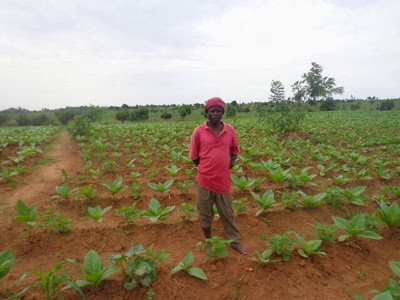Mziza Club members, including the new members, have received the first part of their input loans for 2014 irrigation. Yesterday we delivered onion seeds, which farmers are now sewing in their nurseries. Onions take nearly 6 months from planting to harvesting, and an early start will give the farmers an advantage on the market.
Tuesday, January 28, 2014
Monday, January 27, 2014
Taking the Lead
He's no stranger on this blog: Mr. Japhet is our most outstanding farmer. Now he is an outstanding leader.
Japhet has been the Mziza Farming Club chairman for 3 years. This year, the original club has doubled in number, up to 24 members. As the number of members is growing, the club has split now into three smaller clubs. Japhet is the new club president, responsible for establishing new clubs, training and coaching new members in the area.
Friday, January 24, 2014
Farm Plans
A detailed farm plan is essential in the pursuit of food security. Timing harvests to meet impending shortfalls makes sense from a food secuity and marketing perspective.
We teach farmers how to make a plan and stick to it. As they improve in their gardens, they always want to expand their farms, maximise their production. Planning the year in advance prepares farmers for this gradual increase in production - and workload.
Farmers at Chifuchambewa, Salima, have just undertaken such a training.
Wednesday, January 22, 2014
Beans at Chibanzi
Chibanzi Village has excellent condition for growing beans. This rainy season we are piloting a bean production loan. Farmers are loaned seeds, which they will return twofold after the harvest.
Farmers were given 6 kilograms of beans to plant. This is enough to intercrop (mix more than one crop in a field) with one acre of maize or tobacco. They expect to harvest about 50 kilos of beans each, from which they will return 12 kilos to the seed bank.
In the future, the seedbank will be large enough that farmers can take out 20-30 kilos of seed each. Providing beans throughout the year, in every household. As the seedbank grows, more farmers will be able to join in.
A seedbank also ensures that seeds are available at the time of planting. Otherwise, some farmers end up eating their last beans, leaving nothing to plant when the rainy season arrives.
Monday, January 20, 2014
Getting Out of the Hunger Cycle
Farmers in Malawi grow most of their grain in the upland during the rainy season.
In addition to irrigation, this year we are working with farmers to ensure food security by providing a loan for farm inputs such as fertilizer and quality seeds. We are coaching them on good techniques and timely application of fertilizer, while monitoring their progress.
The potential impact of this project is huge. If the 13 members of the club are successful they will harvest approximatley 1.5 metric tonnes (3,300 lbs.) of corn, per person. That is enough food to feed 5 people for a year. The club as a whole will produce nearly 50,000 meals during the rainy season at an average cost of less than US$0.03 per meal.
Of course, you can't eat just corn flour all year. Nutritional balance is provided by fruit, vegetables, tubers, and legumes, grown in the irrigated gardens. The occasional goat, pig, or chicken keeps things interesting.
Labels:
Africa Windmill Project,
farmers,
fertilizer,
food,
irrigation,
loan,
Maize,
Malawi
Tuesday, January 7, 2014
Maize bests hunger
At Mziza farmers have embraced the techniques we have taught them. This year, more than 10 acres of maize, which was planted early and irrigated until the rainy season started, will mature before the 'hunger season' falls on the country.
Every February, tens of thousands of Malawians run short of maize for their staple food, nsima. Irrigation farmers can time a sizable harvest for February as a stopgap.
10 acres of maize might yield from 1,000 to 2,500 pounds of flour. When mixed with local vegetables, this harvest represents upwards of twenty million calories: that is, 10,000 - 15,000 meals.
On behalf of the farmers, we are very thankful for the support you offer to us!
Every February, tens of thousands of Malawians run short of maize for their staple food, nsima. Irrigation farmers can time a sizable harvest for February as a stopgap.
10 acres of maize might yield from 1,000 to 2,500 pounds of flour. When mixed with local vegetables, this harvest represents upwards of twenty million calories: that is, 10,000 - 15,000 meals.
On behalf of the farmers, we are very thankful for the support you offer to us!
Subscribe to:
Posts (Atom)





.jpg)
.jpg)
.jpg)
.jpg)
.jpg)











